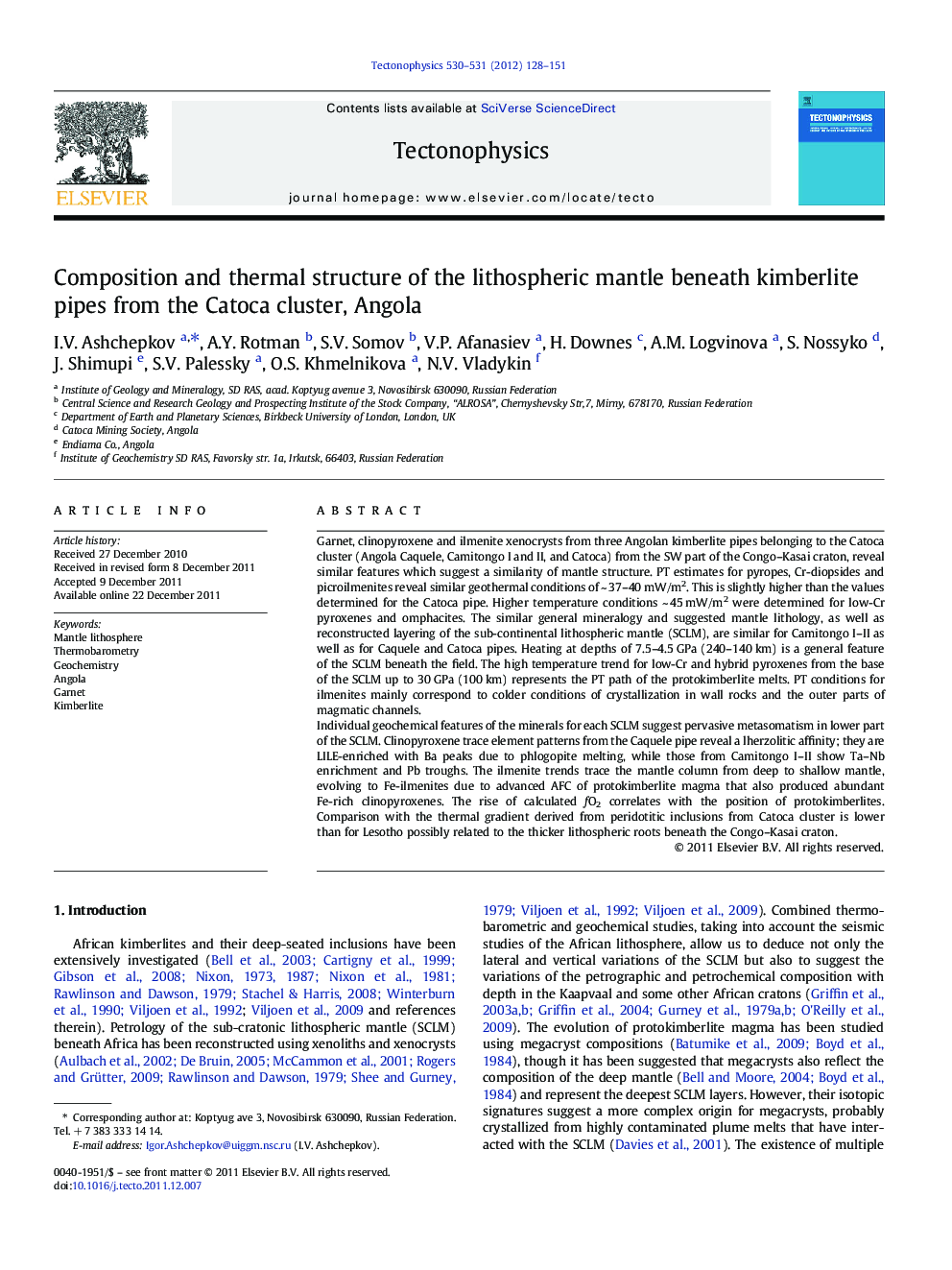| کد مقاله | کد نشریه | سال انتشار | مقاله انگلیسی | نسخه تمام متن |
|---|---|---|---|---|
| 6434264 | 1636827 | 2012 | 24 صفحه PDF | دانلود رایگان |

Garnet, clinopyroxene and ilmenite xenocrysts from three Angolan kimberlite pipes belonging to the Catoca cluster (Angola Caquele, Camitongo I and II, and Catoca) from the SW part of the Congo-Kasai craton, reveal similar features which suggest a similarity of mantle structure. PT estimates for pyropes, Cr-diopsides and picroilmenites reveal similar geothermal conditions of ~Â 37-40Â mW/m2. This is slightly higher than the values determined for the Catoca pipe. Higher temperature conditions ~Â 45Â mW/m2 were determined for low-Cr pyroxenes and omphacites. The similar general mineralogy and suggested mantle lithology, as well as reconstructed layering of the sub-continental lithospheric mantle (SCLM), are similar for Camitongo I-II as well as for Caquele and Catoca pipes. Heating at depths of 7.5-4.5Â GPa (240-140Â km) is a general feature of the SCLM beneath the field. The high temperature trend for low-Cr and hybrid pyroxenes from the base of the SCLM up to 30Â GPa (100Â km) represents the PT path of the protokimberlite melts. PT conditions for ilmenites mainly correspond to colder conditions of crystallization in wall rocks and the outer parts of magmatic channels.Individual geochemical features of the minerals for each SCLM suggest pervasive metasomatism in lower part of the SCLM. Clinopyroxene trace element patterns from the Caquele pipe reveal a lherzolitic affinity; they are LILE-enriched with Ba peaks due to phlogopite melting, while those from Camitongo I-II show Ta-Nb enrichment and Pb troughs. The ilmenite trends trace the mantle column from deep to shallow mantle, evolving to Fe-ilmenites due to advanced AFC of protokimberlite magma that also produced abundant Fe-rich clinopyroxenes. The rise of calculated fO2 correlates with the position of protokimberlites. Comparison with the thermal gradient derived from peridotitic inclusions from Catoca cluster is lower than for Lesotho possibly related to the thicker lithospheric roots beneath the Congo-Kasai craton.
According to the thermobaric reconstructions the thick (270km) lithospheric mantle beneath Congo-Kasai craton determine having initially cold PT gradients (36-38 mwm-2) was metasomatized contained the thick eclogitic lens within 6.5-4.5 Gpa interval, The interactions eclogites and peridotites with the protokimberlites produce the hybrid melts and several PT trajectories and clinopyroxene compositional trends during magma ascend. The dunite channels beneath the largest Catoca pipe served as the major melt conduit.Highlights⺠Thick (270 km) lithospheric mantle beneath SW part of the Congo-Kasai craton determine cold PT gradient (36-38 mwmâ2). ⺠Xenocrysts from Catoca cluster kimberlites show fertile and metasomatites mantle lithosphere within 2.0-5.0 GPa interval. ⺠Mantle xenocrysts beneath Camitongo I and II pipes represent two stages of rising AFC- differentiated protokimberlites. ⺠More depleted and eclogite-rich mantle column beneath Catoca and Caquele pipes are the reason of higher diamond grade. ⺠Several geotherms for Africa mantle xenoliths and diamond inclusions results from the decrease of craton thickness.
Journal: Tectonophysics - Volumes 530â531, 20 March 2012, Pages 128-151